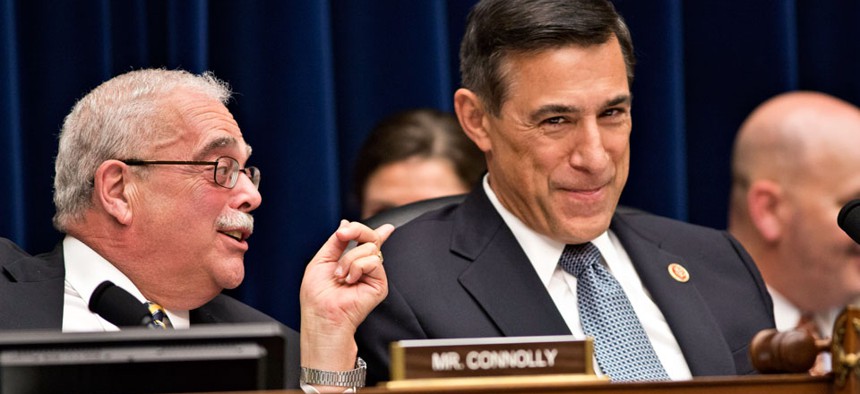Why Federal IT Reform Is Getting Cheaper

House Oversight Committee Chairman Darrell Issa, R-Calif., right, reacts to Rep. Gerry Connolly, D-Va. J. Scott Applewhite/AP
Pared-down Senate bill is projected to cost less than House-passed measure.
The latest plans to overhaul how the government buys and manages information technology are significantly less expensive than the ideas that circulated last year, according to nonpartisan projections.
The version of the Federal IT Acquisition Reform Act currently making its way through the Senate would cost $30 million over five years, according to a new estimate from the Congressional Budget Office. That’s far less than the $145 million CBO projected last November for similar legislation.
The pricier FITARA would have established a central collaboration center to advise agencies on their IT procurements. Participating departments would have paid for this through fees that currently go elsewhere, but CBO still estimated the government would need to spend an additional $18 million a year for it, or about $80 million of the $145 million projection for nearly five years.
The center was stripped from both the Senate bill and the most recent version to pass the House. Even without it, the Senate version, which is somewhat truncated, still looks cheaper, according to estimates.
But Rep. Gerry Connolly, D-Va., warned against putting too much stock in CBO projections, which he said have an unenviable track record for accuracy. “They often dismiss savings because they claim that they can’t measure them,” he said in an interview.
The government budgets about $80 billion a year for IT.
“The bill isn’t in place and we can’t see yet how it will effectuate savings and efficiencies,” he said. “But if it does, which is the whole point of this, you’re talking about potentially billions of dollars every year.”
Sen. Tom Carper, D-Del., who introduced his chamber's legislation with Sen. Tom Coburn, R-Okla., told Nextgov he is hopeful his bill will be taken up by the full Senate soon.
Connolly and Darrell Issa, R-Calif., bipartisan sponsors of the House version, both expressed to Nextgov confidence the Senate and House measures could be reconciled.
“The differences are certainly resolvable,” said a spokesman for the House Committee on Oversight and Government Reform.
The House bill had the backing of industry, according to Trey Hodgkins, senior vice president for the public sector at the Information Technology Industry Council.
“We supported the Senate version of the bill, too, but we believe they should add back some of what they took out,” he said, citing language to improve the acquisition workforce and facilitate the move to cloud computing.






